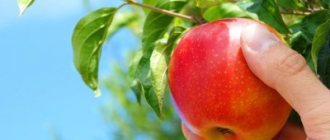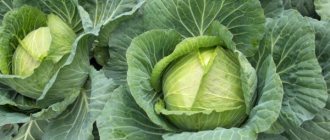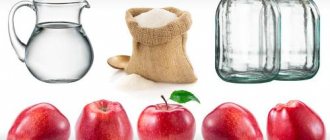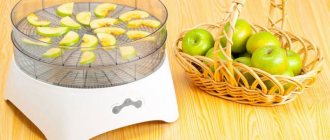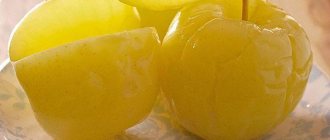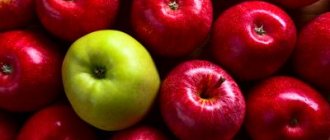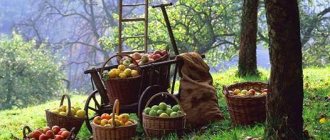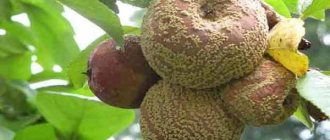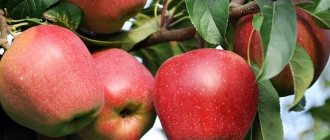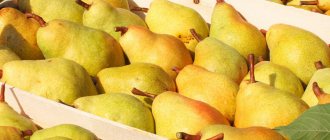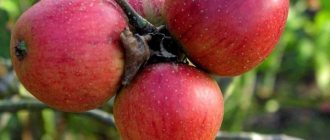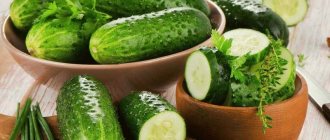Storing apples in our country is a very important and promising business with great potential for growth. After all, apples are still one of the most popular and affordable fruits, which are well preserved during storage until the next harvest. But preserving apples without loss is not a task for amateurs. To successfully store apples, a number of conditions that are well known to professionals must be observed.
The number of newly established orchards is constantly outpacing the growth in the number of fruit storage facilities. This further increases interest in problems related to fruit storage technology. The art of storing fruits is one of those science-intensive areas where success can only be achieved at the intersection of various knowledge.
Apples
Untreated in the cellar, they can last until February at most, and they are sold in stores all year round. It turns out that certain varieties of apples are rubbed with a thin layer of wax before storage - this is a mixture of paraffin, wax and sorbic acid. This coating gives the fruit a glossy shine and allows it to be stored for almost two years. To get rid of wax, you should purchase special detergents for fruits and vegetables, or brush it with a brush under hot water for a few minutes or cut off the peel. Apples are also sprayed with biphenyl. Diphenyl is a hydrocarbon product of petroleum refining, slows down the rotting processes of fruits and vegetables, is a strong allergen, prohibited in the USA and EU countries due to carcinogenicity. Biphenyl is colorless, odorless and tasteless, and therefore people do not see or hear it and quite often do not wash fruits. Biphenyl remains on the hands and enters the body along with fruit. Processed fruits look fresh, but they may have already begun to rot inside, which means they contain a toxin that is dangerous to humans - patulin. Patulin is a mycotoxin, produced by various types of mold fungi, has mutagenic properties, and can cause acute toxicosis in animals and humans. If the apple skin feels sticky and slippery to the touch, it means the fruit has been treated with biphenyl. Biphenyl is not washed off with water; such fruits must be washed with soap and the peels must be cut off. Citrus fruits are also treated with it. But even if the fruits and vegetables have not been rubbed or sprayed with anything, then special smoke bombs are lit at the vegetable bases. The emitted smoke contains a fungicide that protects fruits and vegetables from pathogens of rot, scab and mold. In a ventilated room, the fungicide quickly evaporates, and the residues are washed off with water, so it is not at all dangerous to human health. Subsequently, vegetables and fruits that have not been treated with chemicals can cause more significant harm to the body if rot and mold begin to develop in them. If fresh fruits and vegetables are stored in warehouses that are not protected from rats (the main carriers of infections), then they can become a source of Yersiniosis. To protect yourself, place the vegetables in a weak solution of vinegar or salt for 10 minutes, then rinse with water. After this treatment, the yersiniosis bacteria will die.
The necessary conditions
Apple storage
Whatever conservation option is chosen, it is important to create the necessary conditions. How long the qualities will be preserved is also influenced by the properties of the selected type.
Place
The basement is the best place for storage
An apartment building is not a good place to store apple stock. But in the absence of more suitable alternatives, the fruit will last for about 2 months. To do this, they are first wrapped in cling film or soft paper, and then placed in containers (cardboard, wood) and put in the coolest place with good ventilation.
According to the advice of experienced gardeners, if possible, it is advisable to pre-treat stocks with beeswax, melted in advance. Glycerin or a solution of acetylene acid are also used for processing.
The following cool places are suitable for storing winter supplies:
- fridge
- balcony
- cellar
- basement
Before being placed in the refrigerator, fruits are packed in plastic bags, in which punctures are made for good gas exchange, or wrapped in paper, and then placed in cardboard boxes.
Basements are the ideal environment for food storage
You can save your supplies well if you have an insulated balcony. Although in the very cold it is better to cover the fruits on top with warm things. And for greater reliability, you can use a special thermal box, which is easy to make yourself.
To do this, prepare 2 boxes of thick cardboard, different in size by 15-20 cm, and place them one inside the other. Insulation is placed in the spaces between the boxes, and the outside is lined with foam plastic. The box is ready for use.
Basements are subject to preliminary disinfection treatment:
Calculation:
- water – 10 l
- lime – 1.5 kg
- copper sulfate – 150 g
Tara
The container base can be any
The parameters and configuration of containers that can preserve fruit do not matter. The base from which they are made can be either natural (wood boxes, paper boxes, wicker baskets) or synthetic.
Containers (new or previously used) are cleaned and disinfected before use.
Low temperature and inappropriate humidity can cause damage
Temperature
Apple fruit storage
The most suitable temperature regime to preserve apple tree supplies is: +1C - -1C. At lower temperatures, stored supplies begin to deteriorate.
Humidity
Indoor humidity measuring device
The required humidity level is 85-95%. Below this level, humidity leads to rapid aging of the crop. Good ventilation is also necessary.
Berries
Black and red currants, gooseberries, raspberries, blueberries, blackberries are cooled to freezing point immediately after picking, then placed in a controlled atmosphere, where they can be stored from two weeks to two months. Without artificial refrigeration and special means, the berries are stored for no more than 12 hours. However, in some countries, berries are irradiated with microdoses of radiation, which allows the shelf life to be extended by another week. These technologies have been known for a hundred years and are widely used in China and the United States, but have not been proven to be safe for humans in the long term. Lingonberries and cranberries can be stored in the refrigerator for 10 months to a year.
Storage conditions
Place
Apples in boxes. Photo: Diana Miller
You can store the harvest in the pantry, cellar, basement, balcony and even refrigerator. The main thing is that the conditions for the fruit are optimal.
Tara
Apples are stored well in wooden boxes
The most common containers for winter storage of apples are wooden, cardboard or plastic boxes and various baskets. Remember that good ventilation is needed.
The size of the boxes should not be too large so that the apples do not press on each other with their weight. A small container is also not suitable, since the fruits will be cramped in it.
Storage temperature for apples in winter
Storing apples in the cellar
How well the apples will be stored depends on the temperature. Its optimal value is plus four degrees.
Nothing bad will happen if the temperature is a little higher or a little lower.
If we talk about the minimum limit, then the critical values will be the thermometer readings minus one degree.
In your apartment you can store apples in the refrigerator or on the balcony.
Humidity
Use instruments to measure humidity in storage
The most important indicator affecting the long-term preservation of the crop is air humidity.
Its optimal value is 85-90 percent.
cucumbers
They are not stored for a long time, their lifespan is 2-3 weeks, in a controlled atmosphere - no more than 40 days. To extend their shelf life, they are treated with mixtures of mineral substances, covered with a layer of starch and wrapped in plastic film. They are also treated with paraffin. It creates an invisible film on cucumbers that does not allow moisture to pass through. Cucumbers treated with paraffin can remain juicy and fresh for a long time, but the paraffins themselves, which remain on the peel, can be dangerous. Six months is a critical period for a cucumber; even a paraffin-treated vegetable begins to deteriorate by this time. Before you buy a cucumber, feel it near the stalk; if it is soft, it means it is old and no longer contains any vitamins, taste or smell. Run your hand over the cucumber; if the spines are soft, thin and can be wiped off with your palm, then the cucumber is ready to buy and eat. If the spines are rough and the skin is dark green, it may have been grown with chemicals.
Processing apple trees in different regions
The methods, treatment methods, and preparations used do not depend on the region where the apple tree is grown. They will be the same for the Far East, Siberia, the middle zone or Western Crimea. The only difference is the calendar timing of processing. That is why we tied them to certain phases of plant development - the dormant state (before the buds swell), the period before flowering, flowering, flower falling, fruit set and growth, fruit ripening. Therefore, the recommendations of the presented material are applicable to gardeners in any region.
The most important treatments for apple trees are preventative. If the gardener promptly carries out eradicating sprays with potent preparations, as well as preventive spring treatments, this will almost certainly save him from disappointment.
- Author: Pyotr Vladimirovich Sadovnikov
Hello! My name is Pyotr Vladimirovich. I am 63 years old. By education, he is a mechanical engineer. Rate this article:
- 5
- 4
- 3
- 2
- 1
(3 votes, average: 2.7 out of 5)
Share with your friends!
Potato
one of the most popular root vegetables in Russia, which is prepared for storage in the garden beds. To combat late blight, it is sprayed with copper oxychloride, Bordeaux mixture, zineb, captan and other preparations. Then they are collected, dried, cooled and sent for storage. In the spring, when the potatoes become flabby and are preparing to germinate, they are treated with chemicals: M-1 (methyl ester of a-naphthylacetic acid), which is considered low-toxic for humans, low-toxic hydrel, the breakdown of which produces ethylene, HMA (maleic acid hydrozide) and TB (tetrachloronitrobenzene), which are considered non-toxic. However, the most effective remedy for germination is irradiation with low doses of radiation. Potatoes grown without chemicals will be dense and elastic, and the tuber, which contains a lot of nitrates and pesticides, will be smooth, even and soft. If you hear a crunch when you press a fingernail on a potato, it means there are no pesticides in it. If the nail silently enters the tuber, like cotton wool, it means that the potatoes were grown on nitrogen and mineral fertilizers. Do not buy green potatoes; they contain solanine, which is very toxic even in small quantities. It appears in tubers if the potatoes have been in the sun for a long time.
Carrot
Carrots are poorly preserved, so mechanical and chemical methods of protection are used. Mechanical:
- chalking (soaking in a chalk solution and drying);
- claying (carrots are dipped into a clay mash and dried).
Chemical methods include treatment with mixtures based on glycerin, paraffin with the addition of antiseptics (benzoic acid, sulfur dioxide). Carrots can also be stored in sand mixed with sawdust and a solution of indole (a colorless substance obtained from coal tars with the smell of naphthalene) or other antiseptics.
Tomatoes
Tomatoes are harvested from the branches when they are still greenish-white in color for ease of transportation and to increase shelf life. To combat late blight, after collection they are heated for several hours at a temperature of about 40 ° C. They ripen under the influence of ethylene immediately before sale. In containers with a special gas that penetrates vegetables, tomatoes turn red, but do not ripen - they simply change color due to a chemical reaction at the pigment level, while remaining unripe. This reaction adds substances to the tomato that corrode the soft tissues of the body, causing a burning sensation. The catch is that you experience a similar burning sensation from the juice of a tomato that is grown according to all the rules - from ordinary fruit acids. Typically, the thicker the skin of a tomato, the more nitrates it contains. And also if the tomato has light flesh and white veins, it means there is a lot of nitrates, and if the tomato is bright red both inside and outside, then the nitrate content in it is normal.
The use of chemicals is the only way to preserve plants and reap a healthy harvest. If nitrates are used normally, they will not cause any harm to the human body. But many unscrupulous farms use fertilizers in quantities many times higher than all norms. This is beneficial, vegetables grow quickly and are not affected by pests. The fungus most quickly attacks nitrate vegetables in the form of dark spots, so if you see dark spots on vegetables, this is the first sign that the vegetables were grown with nitrates. To buy cabbage without nitrates, first feel the head of cabbage; healthy cabbage leaves should be dense, and the base of the leaf at the stalk should not be thick. Nitrates are not the worst thing that can be found in vegetables and fruits. It is much worse if pesticides remain in the fruits (vegetables with pesticides almost do not spoil or rot).
Pesticides
chemicals that destroy weeds, insects, pathogenic fungi and other pests. In people in large dosages they provoke allergic reactions and cause poisoning. Over the course of a year, we eat about a handful of chemical fertilizers along with vegetables and fruits. As a rule, all fertilizers and pesticides must be completely decomposed and evaporate from the surface of fruits and vegetables before the fruits ripen. But as experience and practice prove, not everyone follows the rules and regulations for the use of chemicals and, as a result, we are exposed to danger, so we need to carefully select and buy vegetables and fruits on store shelves. In order to protect yourself from purchasing low-quality products, remember simple rules: Ask the seller for a certificate and declaration in order to find out where the fruits and vegetables were grown. Feel the apple; if the peel is sticky and slippery, it means the fruit has been treated with biphenyl. It is better to wash such an apple with soap and remove the peel. If the tomato is bright red both inside and outside, it means that the amount of nitrates in it does not exceed the norm and the thinner the peel, the safer the vegetable. When buying cucumbers, pay attention to the thorns; if they are soft, thin and can be easily rubbed off with your palm, then there are no nitrates in it. If the cucumber is soft and odorless, it means that there are most likely no vitamins and nutrients left in it. If white cabbage has a dense head and the stem of the leaf is not thick, then it contains almost no nitrates. Do not buy potatoes with green spots, they contain solanine and are toxic to the body. Before buying, press the potato with your fingernail; if you hear a crunch, it means there are no pesticides in it.
Add a comment
Varieties for long-term storage
Autumn is the time for home preparations for the winter. With a good harvest from their own plot, every summer resident thinks about what storage should be like. How to store autumn apples so that the fruit remains tasty for a long time at home? Will special conditions be required?
The benefits of homemade apples in cold winter are invaluable. They are rich in iron, magnesium, sucrose and various acids, helping a person survive winter colds and saturate the body with useful vitamins and minerals. But you need to know how to properly preserve ripe and healthy apples throughout the long winter?
Storing ripe autumn apples in various conditions requires knowledge and adherence to rules. Autumn varieties remain fresh for two to three months. However, some methods extend the home maturation period. How to preserve the collected apples until the beginning of spring? Late winter varieties will be able to last until spring. Preserving apples longer is actually very simple. Long-term, high-quality storage is always possible if certain measures are observed.
Varieties for home winter storage:
- Bogatyr. The variety, known to summer residents and breeders, ripens in September. It keeps well for about 6-7 months. By the beginning of January it acquires a rich taste.
- Antonovka. Several varieties are known. It is stored for 2-3 months. Antonovka can be stored in wooden boxes.
- Renet Simirenko. It has high productivity. Holds the record for long-term storage. The taste is wine-sweet.
- Star. The juicy harvest has a sweet and sour taste. Storage – 5-6 months. Suitable for winter storage in any home environment.
- Northern Sinal. Ripens at the end of October. It lasts a long time - 5-6 months. A characteristic feature is the oily peel.
- Renet Chernenko. Late winter, high yield. Apples can be stored in the right conditions for more than 200 days.
- Veteran. Selected by breeders for the elite. Suitable for long periods of time at home in winter. How to keep these late apples fresh? Use simple, ventilated wooden boxes at the right temperature to store late apples.
- Idared. It is winter friendly and will last well in boxes until spring. The pulp is of sufficient density, the peel is resistant and durable. Suitable for storing ripe apples for a long winter.
- Krasnoyarsk sweet. Retains nutritional value in winter. They have an average thickness of the peel and dense, juicy pulp. The housewife chooses apples for storage that are firm and without blemishes.
- Lada. Winter type, seedlings are highly frost-resistant. During storage, sudden changes in temperature should not be allowed. It is stored for 5-6 months. They stay great until spring. Seedlings are planted in areas with harsh climates.
These varieties are well preserved. The harvest must be harvested from September 20 to October 10. This is due to the intensity of maturation. There is no need to allow early harvesting - they will not gain the required juiciness and sugar content. If harvested late, specimens may lose both freshness and taste.
Choose dense fruits. They should not be damaged or cracked. The skin is flawless and dense, allowing you to preserve the fruit longer. It is better to select fruits with roots for home use.
You should remember several selection rules and how to properly store ripe apples for a long time. Summer ones are left in storage for a month. Autumn ones will last about 2 months. Winter storage is 7-8 months. How to store apples for the winter not in the cellar, but in the apartment? Use a refrigerator, pantry, balcony.
